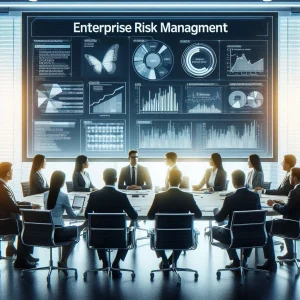Enterprise Risk Management (ERM) is a comprehensive approach that organizations adopt to identify, assess, manage, and mitigate risks that could potentially hinder their ability to achieve their objectives. Regular enterprise risk management audits are essential to ensure the effectiveness of the ERM processes. It plays a crucial role in organizational governance by ensuring that risk management is integrated into the decision-making processes at all levels. This holistic view of risk allows organizations to not only protect their assets but also to seize opportunities that arise from a well-managed risk environment. By aligning risk management with strategic goals, organizations can enhance their resilience and sustainability in an increasingly complex business landscape [1][3].
Internal audits serve as a vital component in the ERM framework. They provide an independent assessment of the effectiveness of risk management processes and controls, ensuring that risks are being identified and managed appropriately. Internal auditors evaluate the adequacy of the ERM framework, recommend improvements, and help organizations align their risk management practices with industry standards and regulatory requirements. This oversight is essential for fostering a culture of accountability and transparency within the organization, ultimately enhancing its governance structure [2][5].
In recent years, the integration of Environmental, Social, and Governance (ESG) factors into ERM audits has gained significant traction. ESG considerations encompass a wide range of issues, including climate change, social inequality, and ethical business practices, all of which can have profound implications for an organization’s long-term sustainability and financial performance. As stakeholders increasingly demand transparency and accountability regarding ESG issues, it becomes imperative for organizations to incorporate these factors into their risk management processes. By doing so, they not only address regulatory requirements but also enhance their reputation and stakeholder trust [4][8][9].
Understanding the foundational elements of ERM audits and the significance of integrating ESG factors is essential for sustainability officers and internal auditors. This integration not only strengthens the organization’s risk management framework but also positions it for long-term success in a rapidly evolving business environment.
The Growing Importance of ESG Factors
In recent years, the integration of Environmental, Social, and Governance (ESG) factors into enterprise risk management (ERM) audits has gained significant traction. This shift reflects a broader recognition of the critical role that sustainability plays in corporate performance and stakeholder trust. Here are some key points highlighting the growing importance of ESG factors in the context of internal audits:
- Rise of Sustainability Reporting: There has been a marked increase in sustainability reporting as organizations strive to meet the expectations of stakeholders, including investors, customers, and employees. Stakeholders are increasingly demanding transparency regarding a company’s ESG performance, which has led to the development of various reporting frameworks and standards. This trend underscores the necessity for internal auditors to incorporate ESG considerations into their audit processes to ensure that organizations are not only compliant but also effectively managing their ESG risks and opportunities [1].
- Regulatory Developments: Regulatory bodies worldwide are implementing new requirements that mandate ESG disclosures and audits. These regulations aim to enhance accountability and transparency in corporate practices related to sustainability. For instance, many jurisdictions are now requiring companies to disclose their ESG strategies and performance metrics, which necessitates a robust internal audit framework to assess compliance and effectiveness. As these regulations evolve, internal auditors must adapt their methodologies to include ESG factors, ensuring that organizations are prepared for scrutiny from regulators and stakeholders alike [2].
- Financial and Reputational Impacts: The implications of ESG issues on organizations can be profound, affecting both financial performance and reputation. Companies that fail to address ESG risks may face significant financial penalties, loss of market share, and damage to their brand reputation. For example, organizations that have been involved in environmental scandals or social injustices have experienced sharp declines in stock prices and consumer trust. Conversely, companies that proactively manage their ESG risks often see enhanced brand loyalty and improved financial performance, demonstrating that effective ESG integration can be a competitive advantage [3].
The increasing focus on ESG factors in enterprise risk management audits is not merely a trend but a fundamental shift in how organizations operate. As sustainability becomes a core component of corporate strategy, internal auditors must embrace this change, ensuring that their audit practices reflect the growing importance of ESG considerations. By doing so, they can help organizations navigate the complexities of the modern business landscape while fostering long-term sustainability and success.
Integrating ESG into the ERM Framework
Incorporating Environmental, Social, and Governance (ESG) factors into Enterprise Risk Management (ERM) audits is becoming increasingly vital for organizations aiming to enhance their sustainability and ethical practices. This integration not only aligns with stakeholder expectations but also strengthens the overall risk management framework. Here are practical steps for sustainability officers and internal auditors to effectively embed ESG considerations within the ERM framework.
Identify Key ESG Risks Relevant to Different Industries
Understanding the specific ESG risks pertinent to your industry is the first step in integrating these factors into the ERM framework. Key risks may include:
- Environmental Risks: These could involve climate change impacts, resource depletion, and regulatory compliance related to environmental laws. For instance, industries like manufacturing may face risks associated with emissions and waste management, while the energy sector might deal with the transition to renewable sources.
- Social Risks: These encompass issues such as labor practices, community relations, and product safety. For example, companies in the retail sector must consider supply chain labor practices, while those in healthcare need to focus on patient safety and ethical marketing.
- Governance Risks: This includes risks related to corporate governance structures, transparency, and ethical business practices. Organizations in finance, for instance, must prioritize compliance with regulations and ethical standards to maintain stakeholder trust.
Suggest Methods for Integrating ESG Metrics into Existing Risk Assessment Processes
To effectively integrate ESG metrics into risk assessment processes, organizations can adopt the following methods:
- Update Risk Assessment Methodologies: Incorporate ESG-related scenarios into existing risk assessment frameworks. This may involve developing specific ESG risk indicators that can be measured and monitored over time, ensuring that these factors are treated with the same rigor as traditional business risks [11].
- Utilize Data Analytics: Leverage data analytics tools to assess ESG risks quantitatively. This can help in identifying trends and potential vulnerabilities, allowing for more informed decision-making and proactive risk management.
- Regular Reporting and Monitoring: Establish a system for regular reporting on ESG metrics. This ensures that ESG risks are continuously monitored and assessed, allowing organizations to adapt their strategies as necessary [12][15].
Highlight the Importance of a Multidisciplinary Approach Involving Various Stakeholders
Integrating ESG factors into the ERM framework requires collaboration across various departments and stakeholders within the organization. A multidisciplinary approach can enhance the effectiveness of ESG integration by:
- Engaging Different Departments: Involve teams from finance, operations, compliance, and sustainability to ensure a comprehensive understanding of ESG risks. Each department can provide unique insights that contribute to a more robust risk management strategy.
- Fostering Communication: Encourage open communication between stakeholders to share knowledge and best practices related to ESG risks. This can lead to a more cohesive strategy that aligns with the organization’s overall goals.
- Training and Awareness: Provide training for internal auditors and relevant staff on ESG issues and their implications for risk management. This will help build a culture of sustainability within the organization and ensure that ESG considerations are embedded in decision-making processes [2][10].
By following these steps, organizations can effectively integrate ESG factors into their ERM audits, enhancing their resilience and ensuring long-term sustainability. This proactive approach not only mitigates risks but also positions the organization favorably in the eyes of stakeholders who increasingly prioritize ethical and sustainable practices.
The Role of Internal Auditors in ESG Integration
As organizations increasingly recognize the significance of Environmental, Social, and Governance (ESG) factors, internal auditors play a crucial role in integrating these considerations into Enterprise Risk Management (ERM) audits. This integration not only enhances the effectiveness of risk management strategies but also aligns with the growing expectations of stakeholders regarding sustainability and ethical practices.
Assessing the Effectiveness of ESG Risk Management Strategies
Internal auditors are positioned to evaluate how well organizations manage ESG risks. This involves:
- Reviewing Policies and Procedures: Auditors should assess existing policies related to ESG risk management to ensure they are comprehensive and aligned with best practices. This includes examining how these policies are implemented and monitored within the organization [1].
- Evaluating Risk Mitigation Efforts: By analyzing the effectiveness of risk mitigation strategies, auditors can identify gaps in the organization’s approach to ESG risks. This includes assessing whether the organization has established appropriate metrics and reporting mechanisms to track ESG performance [11].
- Identifying Opportunities: Beyond risk assessment, internal auditors can help organizations uncover unexpected opportunities related to ESG factors. This proactive approach can lead to enhanced business strategies that leverage sustainability as a competitive advantage [3].
Skills and Tools for Evaluating ESG Factors
To effectively evaluate ESG factors, internal auditors need to develop specific skills and utilize appropriate tools:
- Knowledge of ESG Frameworks: Familiarity with various ESG frameworks and standards, such as the Global Reporting Initiative (GRI) or the Sustainability Accounting Standards Board (SASB), is essential. This knowledge enables auditors to assess compliance and performance against recognized benchmarks [10].
- Analytical Skills: Strong analytical skills are necessary to interpret ESG data and assess its implications for the organization. Auditors should be adept at using data analytics tools to identify trends and anomalies in ESG reporting [9].
- Stakeholder Engagement: Internal auditors must engage with various stakeholders, including sustainability officers and management, to understand the organization’s ESG objectives and challenges. This collaboration is vital for developing a comprehensive audit approach that addresses ESG risks effectively [7].
Developing Audit Plans that Include ESG-Related Risks
Creating audit plans that incorporate ESG-related risks requires a strategic approach:
- Risk Assessment Framework: Auditors should integrate ESG risks into their overall risk assessment framework. This involves identifying and prioritizing ESG risks alongside traditional business risks, ensuring a holistic view of the organization’s risk landscape [12].
- Tailored Audit Objectives: Audit objectives should reflect the specific ESG risks relevant to the organization. This may include assessing the effectiveness of sustainability initiatives, compliance with environmental regulations, and the impact of social factors on business operations [13].
- Continuous Monitoring and Reporting: Establishing mechanisms for ongoing monitoring of ESG risks is crucial. Internal auditors should recommend regular reviews and updates to the audit plan based on emerging ESG trends and regulatory changes, ensuring that the organization remains responsive to evolving risks [8][14].
Internal auditors have a pivotal role in integrating ESG factors into ERM audits. By assessing the effectiveness of ESG risk management strategies, developing the necessary skills and tools, and creating comprehensive audit plans, auditors can help organizations navigate the complexities of sustainability and enhance their overall risk management framework. This proactive approach not only supports compliance but also fosters long-term resilience and success in an increasingly ESG-focused business environment.
Challenges in Implementing ESG Factors in Audits
Integrating Environmental, Social, and Governance (ESG) factors into enterprise risk management audits presents a unique set of challenges that organizations must navigate. As sustainability officers and internal auditors work to incorporate these considerations into their audit processes, understanding these obstacles is crucial for effective implementation.
Common Challenges
Data Availability, Quality, and Reliability:
- One of the primary hurdles in integrating ESG factors is the lack of consistent and reliable data. Many organizations struggle with inadequate or incomplete risk assessments related to ESG issues, which can hinder the accuracy of audits [8].
- Furthermore, ESG-related reporting often suffers from methodological constraints, as traditional risk management models typically rely on historical data that may not adequately reflect current or future ESG risks [11]. This discrepancy can lead to challenges in measuring and monitoring ESG risks effectively.
Cultural and Organizational Resistance to Change:
- Resistance to change within an organization can significantly impede the integration of ESG factors into audits. This resistance may stem from insufficient commitment from leadership and board members, which is essential for driving an effective ESG strategy [8].
- To overcome this challenge, organizations should focus on fostering a culture that values sustainability and recognizes the importance of ESG considerations. Engaging stakeholders at all levels and providing education on the benefits of integrating ESG into audits can help mitigate resistance and promote a more supportive environment for change.
Complexity of Measuring and Reporting ESG Outcomes:
- The complexity involved in measuring and reporting ESG outcomes poses another significant challenge. ESG factors encompass a broad spectrum of issues, including climate change, resource scarcity, and labor practices, making it difficult to establish clear metrics for evaluation [9].
- Additionally, organizations often face uncertainty regarding reporting standards and frameworks, which can complicate the process of ensuring accountability and transparency in ESG reporting [13]. Developing a coherent strategy for ESG measurement and reporting is essential for enhancing the quality and availability of ESG data, ultimately supporting more effective audits [12].
Future Trends in ESG and ERM Audits
As the landscape of enterprise risk management (ERM) continues to evolve, the integration of Environmental, Social, and Governance (ESG) factors into internal audits is becoming increasingly critical. This section explores emerging trends that are shaping the future of ESG integration in ERM audits, particularly for sustainability officers and internal auditors.
Role of Technology and Data Analytics
- Enhanced Assessments: Technology and data analytics are revolutionizing how organizations assess ESG risks. By leveraging advanced analytics, companies can gain deeper insights into their ESG performance, identify potential risks, and track compliance with ESG standards more effectively. This integration allows for a more comprehensive understanding of how ESG factors impact overall business risk and performance [6][8].
- Real-Time Monitoring: The use of technology enables real-time monitoring of ESG metrics, allowing organizations to respond swiftly to emerging risks. This capability is essential for maintaining compliance and ensuring that ESG considerations are embedded in the decision-making processes [11].
- AI and Machine Learning: The adoption of AI and machine learning tools can enhance the accuracy of ESG assessments by analyzing vast amounts of data to identify patterns and trends that may not be immediately apparent. These technologies can also help in predicting future risks and opportunities related to ESG factors [7][8].
Potential Regulatory Changes
- Increased Scrutiny: As stakeholders demand greater transparency and accountability regarding ESG practices, regulatory bodies are likely to implement stricter guidelines and reporting requirements. This shift will necessitate that internal auditors adapt their practices to ensure compliance with evolving regulations [14].
- Standardization of ESG Reporting: The push for standardized ESG reporting frameworks is gaining momentum. Internal auditors will need to familiarize themselves with these standards to effectively evaluate and report on their organizations’ ESG performance. This standardization will also facilitate better comparisons across industries and enhance stakeholder trust [10].
- Impact on Audit Practices: Regulatory changes will likely influence audit methodologies, requiring auditors to incorporate ESG considerations into their risk assessments and audit plans. This integration will help organizations mitigate risks associated with non-compliance and enhance their overall sustainability strategies [15].
Proactive Approach to ESG Developments
- Continuous Learning: To stay ahead of ESG-related developments, internal auditors and sustainability officers must engage in continuous learning and professional development. This includes staying informed about emerging trends, regulatory changes, and best practices in ESG integration [11][12].
- Collaboration Across Departments: A proactive approach involves fostering collaboration between internal audit teams and other departments, such as compliance, risk management, and sustainability. This collaboration can lead to a more holistic understanding of ESG risks and opportunities, ultimately enhancing the effectiveness of audits [10][15].
- Strategic Planning: Organizations should incorporate ESG considerations into their strategic planning processes. By aligning ESG goals with business objectives, internal auditors can ensure that audits are not only focused on compliance but also on driving sustainable growth and resilience [9].
The integration of ESG factors into enterprise risk management audits is not just a trend but a necessity for organizations aiming to thrive in a rapidly changing business environment. By embracing technology, adapting to regulatory changes, and adopting a proactive approach, internal auditors can play a pivotal role in enhancing their organizations’ sustainability efforts and overall risk management strategies.
Conclusion
In today’s rapidly evolving business landscape, the integration of Environmental, Social, and Governance (ESG) factors into Enterprise Risk Management (ERM) audits has become not just beneficial but essential. The critical role of ESG considerations in modern risk management cannot be overstated, as they significantly influence a company’s long-term sustainability and financial performance. By recognizing and addressing ESG risks, organizations can enhance their resilience and ensure a more sustainable future.
Collaboration between internal auditors and sustainability officers is vital for effective ESG integration. This partnership fosters a comprehensive understanding of the risks and opportunities associated with ESG factors, enabling organizations to develop robust strategies that align with their overall risk management framework. By working together, these professionals can create a unified approach that not only meets regulatory requirements but also drives positive change within the organization.
As we move forward, it is imperative for sustainability officers and internal auditors to take proactive steps in enhancing their ESG integration efforts within ERM audits. This call to action encourages organizations to assess their current practices, identify gaps, and implement strategies that incorporate ESG considerations into their risk management processes. By doing so, they will not only comply with emerging regulations but also position themselves as leaders in sustainability and responsible governance, ultimately contributing to a more sustainable and equitable world.
Find out more about Shaun Stoltz https://www.shaunstoltz.com/about/
This post was written by an AI and reviewed/edited by a human.



